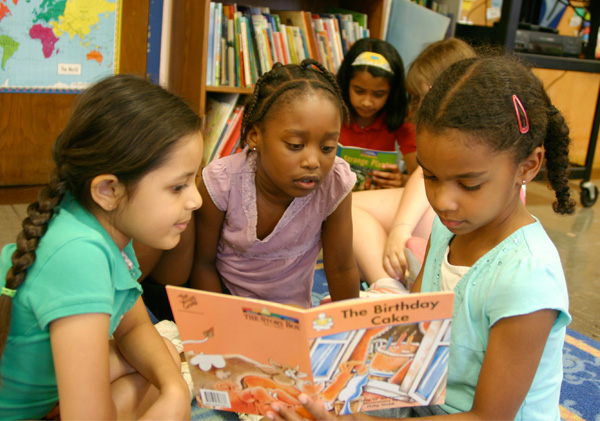What do teachers need to know about students who are learning to speak English?
Page 1: English Learners
 The term English learners (EL) refers to students whose first language is not English but who are learning English. Educators may be familiar with an older term, English language learners (ELL), that is used less frequently. The term limited English proficient (LEP), though generally considered to be outdated, is still used by the federal government.
The term English learners (EL) refers to students whose first language is not English but who are learning English. Educators may be familiar with an older term, English language learners (ELL), that is used less frequently. The term limited English proficient (LEP), though generally considered to be outdated, is still used by the federal government.
Although as a group, English learners attending schools in the United States speak more than 400 languages, the majority of them, some eighty-five percent, are native Spanish speakers. In fact, just five languages—Spanish, Vietnamese, Hmong, Chinese, and Korean—account for ninety-five percent of the language variance. Because the number of ELs continues to increase in schools across the country, it is likely that every teacher at one time or another will work with them.
Research Shows
Though English learners may have good conversational English skills, they may lack the vocabulary and academic language that is central to success in school. Because of this, ELs generally score lower on academic achievement tests than do their English-speaking peers:
- Seventy-one percent of fourth-grade English learners scored below basic (“Partial mastery of prerequisite knowledge and skills that are fundamental for proficient work at each grade level”) in standardized reading assessments. This was the case for thirty percent of their non-EL peers.
- Forty-three percent of fourth-grade English learners scored below basic in math, whereas sixteen percent of their non-EL peers did so.
- Seventy-four percent of eighth-grade English learners scored below basic on reading achievement tests and similarly on math, compared to approximately a quarter of their non-EL peers.(U.S. Department of Education, 2009)

In order to improve the educational outcomes for English learners, it is important that teachers know how to work effectively with them. To begin, teachers should avoid making generalizations about the ability of ELs based on their backgrounds. In fact, ELs are a heterogeneous group with varied characteristics that include their:
- Familiarity with English
- School experiences
- Socioeconomic status
We’ll look at each of these distinctions in more detail below.
Familiarity with English
Teachers sometimes assume that all of their English learners have similar language needs; however, these students demonstrate a wide range of familiarity and comfort with English. Some are recent immigrants with little or no knowledge of the English language. Others are born in the United States yet might still be learning English. Some ELs have a strong first language and are learning English, and others are trying to learn both their primary language and English at the same time. Inspect the graphic below to get a sense of some of the language distinctions among English learners.
of English skills
knowledge
of English
at once
a second language
School Experiences
As with their familiarity with English, ELs also have a broad range of school experiences. In some cases, recent immigrants may have had little previous schooling. For example, they may have spent years in a refugee camp. Others might have received a quality education in their home country, including instruction in English, and arrived in the United States prepared to continue their education. The graphic below depicts a few examples of the kinds of school experiences these students might have had.
Socioeconomic Status
Socioeconomic status (SES) is another factor that distinguishes students from one another and can affect a student’s school performance. Some ELs are from wealthy or middle-income backgrounds, while others live in poverty. Regardless of their SES, all students have valuable experiences that both contribute to the classroom and should be used as a basis for their learning.
Leonard Baca, former Director of the BUENO Center for Multicultural Education, summarizes the distinctions among English learners (time: 0:56).

Leonard Baca, EdD
School of Education
University of Colorado at Boulder
Transcript: Leonard Baca, EdD
English language learners are a very diverse group. First of all, we know there’s quite a few of them, several million, and they come from many different backgrounds and languages. Although about seventy-five percent are Spanish speakers, there are many different language groups represented. Among them there again are many differences. Some of them have to do with socioeconomic levels. The main difference is their proficiency in English. They range all the way from knowing no English at all, to being fairly proficient but still lacking in the finer points of academic language. So teachers need to keep in mind that these kids are very diverse, and we can’t treat them as though they were all the same or that they learn the same. They learn in different ways and in different rates. They have different learning styles, so the teacher has to adapt quite a bit for each language learner.
For Your Information
In addition to understanding their English learners’ distinct backgrounds, it is important for teachers to recognize that family support is another factor that affects EL students’ chances for academic success. Fostering a welcoming atmosphere in the school and, whenever possible, communicating with parents in their native language is critical. Doing so, teachers can develop a relationship with these families and gain an understanding of the families’ goals and values for their children.
Activity
|
Math is easy for English learners because numbers are universal.
feedback
Immersion is the best way to learn a second language.
feedback
A student’s first language interferes with his or her ability to learn a second language.
feedback
It takes between five to seven years to become proficient enough in a second language to succeed in an English-only classroom.
feedback
|